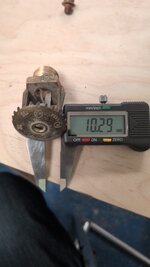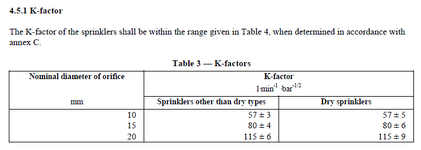Hi everyone,
I’m looking into the compatibility between UL-listed K-factors and European classification under UNI EN 12259-1. Specifically, I’m reviewing a Viking upright sprinkler (presubimely marked 5.6 gpm/√psi), with the typical UL listing and a 1/2” NPT thread. The orifice appears to be in the 10 mm nominal range (photo attached). According to Table 3 of UNI EN 12259-1, a 10 mm nominal orifice corresponds to a K-factor of 57 ±3 l/min/√bar. However, UL 199 allows sprinklers to be classified as 5.6 even with some variation in orifice geometry, and the unit conversion from 5.6 US gpm/√psi gives approximately 80 l/min/√bar, which seems inconsistent with the European 10 mm / K57 classification.
I'm attaching:
Thanks for your insights — I'm trying to understand how this is approached in practice during technical evaluations or retrofitting in Europe.
I’m looking into the compatibility between UL-listed K-factors and European classification under UNI EN 12259-1. Specifically, I’m reviewing a Viking upright sprinkler (presubimely marked 5.6 gpm/√psi), with the typical UL listing and a 1/2” NPT thread. The orifice appears to be in the 10 mm nominal range (photo attached). According to Table 3 of UNI EN 12259-1, a 10 mm nominal orifice corresponds to a K-factor of 57 ±3 l/min/√bar. However, UL 199 allows sprinklers to be classified as 5.6 even with some variation in orifice geometry, and the unit conversion from 5.6 US gpm/√psi gives approximately 80 l/min/√bar, which seems inconsistent with the European 10 mm / K57 classification.
- Have you encountered UL-listed 5.6 sprinklers that, due to actual geometry, fall within the K57 class under UNI EN?
- Are there known cases where K-factors "overlap" across standards?
I'm attaching:
- A photo of the sprinkler head,
- An excerpt from UNI EN 12259-1 Annex C.
Thanks for your insights — I'm trying to understand how this is approached in practice during technical evaluations or retrofitting in Europe.


